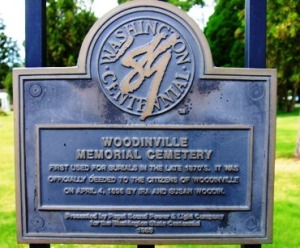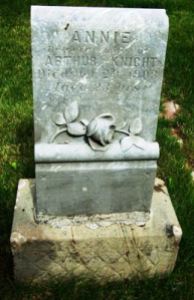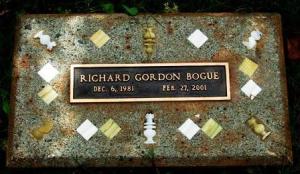“First used for burials in the late 1870s, it was officially deeded to the citizens of Woodinville on April 4, 1898 by Ira and Susan Woodin.”
While some historical cemeteries might have a tumultuous history, many are still fortunate to play a quiet, yet well-loved part in their local communities. Woodinville Mead is one such place (or so it might seem). Loggers were the first to call this spot home but it was the farmers who helped turn a meandering bog into today’s award-winning wineries and microbreweries.
At one time, this area of King County (approximately 20 miles northeast of Seattle) was so heavily forested that tree stumps were used as shelters and even temporary housing. Sawmills sprouted at various sites throughout what was to become Washington Territory so that by 1889, the year of statehood, 310 mills from the Columbia to the Canadian line, were cutting 1.06 million board feet of lumber. *
However, loggers had little use for the cleared land and as they moved deeper into the vast forests, farmers discovered the rich soil, spreading the news to family and friends seeking a respite from the urban rush of late 19th century Seattle. Soon, farmers quickly outstripped the number of remaining loggers.
One of the earliest residents was the Woodin family.
In 1871, Ira and Susan Woodin, along with their two daughters, took advantage of President Lincoln’s 1862 Homestead Act that allowed families to claim up to 160 acres for development. As there were no established roads at the time, the family wisely settled along the Squak Slough (later renamed the Sammamish River). The Woodin home eventually became the first post office, first school, and half-way house between Seattle and the up-river settlements.
Squak Slough served as the main waterway to and from Seattle until 1887 when the Seattle-Lakeshore & Eastern Railway finally reached the town. Up until that time, the only way to get to and from Seattle and Woodinville was to use flat bottomed scows that navigated the reed-choked swampy byways.
The rich soil may have offered multiple rewards, but accidents and sickness were an accepted part of early pioneer life. While there had certainly been a number of deaths with the first settlers, the earliest recorded burials in what eventually became the Woodinville cemetery, were for two girls who died from an 1888 diphtheria outbreak.
In 1898, the Woodin family formally donated the one-acre plot as the official town cemetery. Since then, a variety of interesting stones have added their character to the site. One of the earliest headstones is for Annie Knight who died at 23.
At first glance, it’s a simple stone with only a rose to signify the loss of a young woman but closer inspection reveals an intricately carved design that almost makes the flower 3-D.
Another intriguing marker is an anvil commemorating Johann Koch, who claimed both a fiery temperament and a strong prejudice against communists. Born near Heidelberg, Germany, he emigrated to the United States in 1900 and eventually, Woodinville, where he worked as the village blacksmith for many years. The stone is discreetly located behind two other upright markers and is easy to miss.
Sometimes, walking the edges of a graveyard has its own rewards, finding like this 2001 memorial to Richard Bogue. No interpretation is needed here for this former chess player.
However, like most historic cemeteries, Woodinville Mead is missing headstones and that’s where its group of devoted volunteers have come forward, perhaps inadvertently adding a mystery to the otherwise well-maintained plot. Scattered throughout the site are small, flat markers that often commemorate a single child or a mother and her two children. Sometimes, it’s a little more enigmatic, like the puzzling marker for a mute, deaf man who died in 1888.
Stones like these are like catnip to cemetery enthusiasts and mystery writers alike. Who was he? Did he play a part in Woodinville’s history or was he just passing through? Isn’t it interesting how an ostensibly simple community cemetery still manages to retain a fascinating sense of mystery for its visitors?
Perhaps these riddles are best pondered with a glass of wine at the nearby Chateau Ste. Michelle winery…
Resources:
• History of Woodinville Cemetery
*Prouty, Andrew Mason: More Deadly Than War: Pacific Coast Logging 1827 – 1981
Garland Publishing, Inc. New York © 1985. Pg 8.









